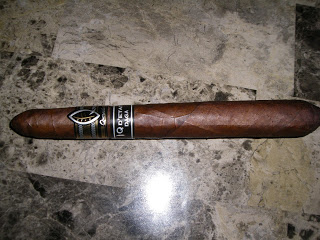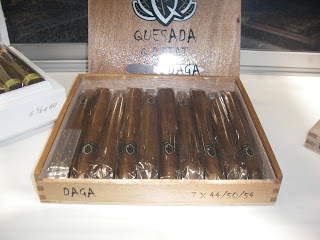 |
| Q D’Etat Daga |
The Quesada Q D’Etat Daga is the third, and currently the final of Quesada’s limited edition Q D’Etat series. For the Q D’Etat line, there is an undelying theme behind this line of cigars. It is intended to support the industry’s battle
against the government and anti-tobacco factions. There are three vitolas in the line and each has been rolled out individually throughout 2012. Each box of cigars in this series includes a form to register for the Cigar Rights of America. Much of the details of the Q D’Etat Daga were kept quiet until a few days before the 2012 IPCPR Trade Show where the cigar was officially launched. The Daga comes in a very unorthodox salomon shape. It also comes in a different blend than the Dominican puros that made up the first two Q D’Etat cigars – the Molotov and the Howitzer. I was a little skeptical about Quesada going with a salomon shape as I often find this shape disappoints more than pleases me. With the case of the Daga, I could not have been more wrong. Not only is this the best release of the Q D’Etat series, this might be one of the finest salomons I have ever smoked.
The Q D’Etat line follows a theme of weaponry. The first cigar, the Molotov was rolled in the shape of a Molotov Cocktail. The second cigar, the Howitzer was a 6 x 60 and meant to represent a piece of artillery that is apart of the cannon family. This Daga gets its name from being a “dagger” like weapon and this is reflected in the salomon shape. Like the first two Q D’Etat cigars, the Daga is a limited release with only 1000 boxes of ten being produced.
Let’s break down the Q D’Etat Daga and see what this cigar brings to the table.
Blend Profile
As mentioned in the introduction, the blend for the Q D’Etat Daga is different. The blend of the Daga is based on the Quesada 35th Anniversary. While the Molotov and Howitzer were Dominican puros, the Daga is a multinational blend.
Wrapper: Ecuadorian Arapiraca
Binder: Cuban Seed & Criollo 98
Filler: Dominican Republic & Nicaragua
Vitolas Available
The Daga is an unorthodox salomon. It is thinner toward the cap, and reaches its thickest point closest to the foot before tapering. The dimensions for the Q D’Etat Daga are listed 7 x 44/50/54. Because they are thicker closer to the footer, the are arranged in the boxes of 10 in an fashion of positioning the cigars cap first and footer first in an alternating fashion.
 |
| Alternating arrangement of the Q D’Etat Daga boxes of 10 |
While the Daga differs in its blend from the other Q D’Etat releases, we list all three for completeness.
Molotov: 5 x 38/58/44
Howitzer: 6 x 60
Daga: 7 x 44/50/54
Appearance
The Ecuadorian Arapiraca is a cross of coffee bean color and colorado red. It also has some dark spots. The wrapper has a bumpy feel to it and is very oily in complexion. Wrapper seams and veins are both visible. There also was a cocoa-like aroma from the footer. The salomon itself is well-packed and this played a key role in providing a very positive smoking experience.
There are two bands on the Quesada Q D’etat Daga. The first is the what has become the defacto Quesada band – silver, black, and gold highlighted with the Q-shaped leaf. There is a second band that is black with silver striping on the top and bottom. In silver text it says “Q D’ETAT” with the text “DAGA” in smaller silver font below it. There are two small sword-like designs that surround the text to the left and right.
Preparation for the Cigar Experience
For my cigar experience with the Q D’etat Daga, I went with a straight cut into the tip of the cigar. I commenced with the pre-light draw and was treated to notes of coffee, natural tobacco sweetness, and a hint of cedar. Overall I was very pleased with this pre-light draw. I then proceeded to light the Daga. I’ve been getting into a habit of completely toasting the foot of salomons and perfectos – and did the same with this cigar. Once properly lit, it was time to see what the actual smoking experience would bring to the table.
Flavor Profile
I did not find the Q D’etat Daga to be a cigar that was going to be overly complex or one with a lot of flavor transitions. I did find the Daga to be a cigar to be one that provides some outstanding flavors.
The start to the Daga picked up where the pre-light draw left off. I got notes of coffee and natural tobacco sweetness. The spice was more of a classic pepper and was more present on the afterdraw. As the cigar progressed through the first half, the primary notes turned into a combination of chocolate and coffee. I wouldn’t categorize the flavor as “mocha” as I picked up the chocolate and coffee individually. The natural tobacco sweetness subsided and the pepper spice remained on the after-draw.
As the Daga moved into the second half, the spice started to fold in with the primary notes. By the last third, the pepper becomes the primary note. The chocolate and coffee notes became secondary. The finish had some spice. The resulting nub was softer to the touch (I expected that with a salomon). The nub was cooler in temperature (and that was a pleasant surprise).
Burn and Draw
The fact that the Daga is a well-packed salomon is a testament to its construction. This is reflected in the burn and draw. This is one of the best burning salomons I have had in a long time. It was very low maintenance requiring minimal touch-ups. I also think the unorthodox shape plays very well when it comes to the burn. The thicker ring toward the end prevented this cigar from burning hot at an earlier stage (and in this case, it didn’t burn hot at all). As a result this had an ideal burn temperature. It also had an ideal burn rate.
The draw was flawless. Much like this was one of the best burning salomons I have had, this was one of the better salomon vitolas to draw on.
Strength and Body
From a nicotine profile, the Daga starts out as a medium to full strength cigar. As the Daga moves into the last third, the strength really kicks it up a notch. The Daga finishes up full strength as the final third begins. The depth of the flavor notes follow a similar pattern. The Daga starts off medium to full-bodied. As the Daga moves into the last third, there also is a nice kick in terms of the flavor notes as the Daga moves to full-bodied. The Daga does an excellent job at balancing the attributes of strength and body from start to finish.
Final Thoughts
I’m not sure what more I can add here. Putting the 35th Anniversary blend into this shape was a stroke of genius, and it was a midas-touch in terms of getting it to work in a salomon. Add to the fact that the cigar is well constructed, and you have an outstanding cigar experience. Given that this cigar really kicks it up a notch into a full strength, full-bodied smoke at the end, I would probably recommend this for a more seasoned cigar enthusiast. As for myself, this was my favorite blend of the Q D’Etat series. It is not only a cigar I would reach for again, but one worth considering a box purchase for.
Summary
Burn: Excellent
Draw: Excellent
Complexity: Low
Strength: Medium to Full (1st 2/3), Full (Last third)
Body: Medium to Full (1st 2/3), Full (Last third)
Finish: Good
Assessment: Memorable
Score: 94
Source: One cigar for this assessment was purchased from Outland Cigars in Charlotte, North Carolina. The other cigar for this assessment was gifted to me by a friend.




